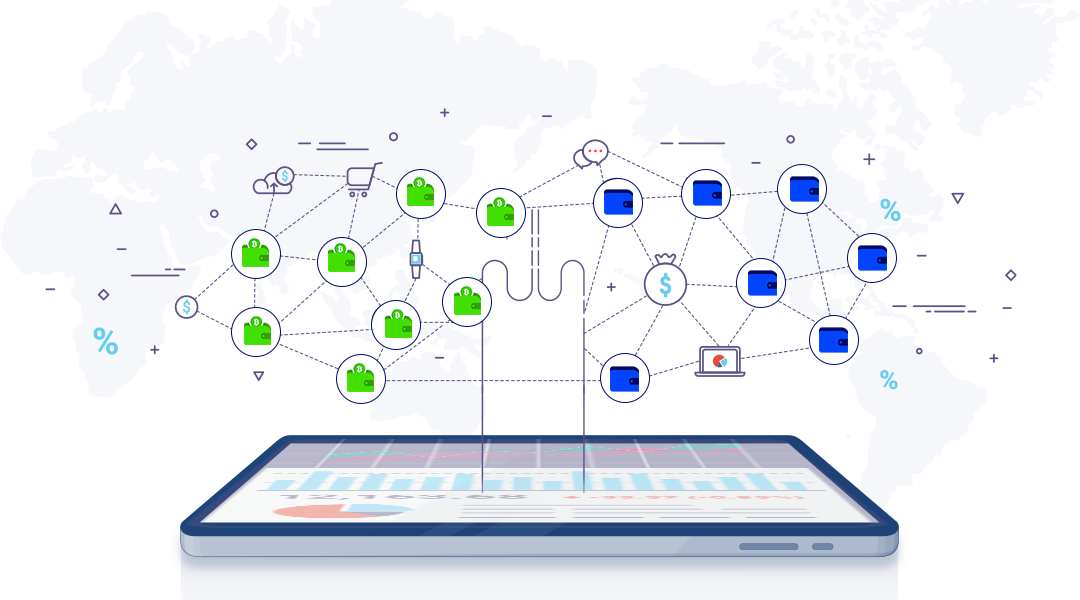
How Does Blockchain Work
Imagine this scenario; you're in an international airport waiting to board a flight to a neighbouring country, so you're all checked in, seated and waiting to be called upon to board your flight. So you got a little bored and started paying attention to the Flight Information Display System(FIDS) - a computer system used in airports to display flight information to passengers, in which a computer system controls mechanical or electronic display boards or monitors in order to display arriving and departing flight information in real-time.
This acts like a centralised distribution channel that gives everybody information and access to all flight information at a point in time. So at any point in time, everyone can see the departure and arrival times of different aircraft even if it doesn't concern you, and everyone gets to see the real-time change or modifications to this information like late arrival time or, worse, cancelled flights giving people first-hand knowledge at that moment. Blockchain works in this way, but with two distinct differences; it's decentralised, which means a single entity can't control it. Also, it can't be modified once written, which gives it state-of-the-art security.
It's important to note that Blockchain technology has a way more complex system than FIDS, but they both use one instance of a similar concept.
What Is BlockChain Technology?
A blockchain is a type of distributed network that allows the development of applications, technologies, and features that create value over the internet. Better explained, the concept of blockchain or blockchain technology involves a joint network of superior systems that verify, record and store information necessary to build and execute transactions and other internet-supported processes with speed and convenience.
According to Wikipedia, "The first decentralised Blockchain was conceptualised by a person (or group of people) known as Satoshi Nakamoto in 2008. Nakamoto improved the design in an important way using a Hashcash-like method to timestamp blocks without requiring them to be signed by a trusted party and introducing a difficulty parameter to stabilise the rate at which blocks are added to the chain. The design was implemented the following year by Nakamoto as a core component of the cryptocurrency bitcoin, where it serves as the public ledger for all transactions on the network."
While Blockchain is still primarily closely associated with cryptocurrency, but that's just less than 10%; Blockchain can function in so many other industries:
- Elections
- Financial Election
- Education
- Unified database
- Healthcare
How Does Blockchain Technology Work?
Blockchain technology operates on a complex yet elegant system that ensures transparency, security, and trust in the digital world. To better understand Blockchain's workings, we'll look at its inner workings and the key processes that enable its success as a crypto platform.
1. Decentralisation and Network Consensus: At the heart of Blockchain lies its decentralised nature. Unlike traditional centralised systems, where a single authority has control over data, Blockchain operates on a network of nodes (computers). Each node in the network maintains a complete copy of the Blockchain, ensuring redundancy and eliminating the risk of a central point of failure.
Consensus mechanisms play a critical role in validating and adding new transactions to the Blockchain. Popular consensus algorithms include:
- Proof of Work (PoW): In PoW, miners compete to solve complex mathematical puzzles using computational power. The first miner to solve the puzzle gets the right to add the following block to the chain and is rewarded with newly created cryptocurrency (e.g, Bitcoin).
- Proof of Stake (PoS): In PoS, validators are chosen to create new blocks based on the number of tokens they "stake" or lock up as collateral. Validators are incentivised to act honestly, as they can lose their staked tokens in case of malicious behaviour.
2. Transaction Verification and Block Formation: When a user initiates a transaction, it is broadcasted to the network. Nodes then verify the transaction's validity by ensuring that the sender has sufficient funds and that the transaction adheres to the consensus rules.
Once verified, the transaction is bundled with other validated transactions to form a new block. Each block contains a unique cryptographic hash referencing the previous block's hash, effectively linking it to the chain.
3. Mining and Block Validation: In a Proof of Work blockchain, miners compete to solve complex mathematical puzzles. The first miner to solve the puzzle broadcasts the newly created block to the network. Other nodes then validate the block, ensuring it adheres to the network's rules and that its transactions are legitimate.
Upon successful validation, the block is added to the Blockchain, becoming a permanent and immutable record of transactions. PoW's computational intensity ensures that adding new blocks requires significant effort, making it computationally infeasible to tamper with past transactions, thus enhancing security.
4. Consensus and Trust: The decentralised and transparent nature of Blockchain ensures that no single entity can control the entire network or alter historical data. Each participant can verify the validity of transactions and the entire transaction history through their copy of the Blockchain.
Consensus mechanisms create a harmonious agreement among network participants about the state of the Blockchain. As long as the majority of nodes in the network act honestly, the Blockchain remains secure and trustworthy.
5. Immutability and Data Integrity: Once a block is added to the Blockchain, it becomes immutable, meaning it cannot be altered or deleted. Any attempt to modify the data within a block would change its cryptographic hash, breaking the link to the subsequent block and rendering it invalid.
The immutability of Blockchain ensures data integrity, making it an ideal solution for applications where tamper-proof records and historical accuracy are paramount.
How is Busha using Blockchain?
Busha, a leading Nigerian cryptocurrency exchange with a presence in Kenya, is at the forefront of leveraging blockchain technology to redefine the landscape of financial services in Africa. With diverse products and services, Busha empowers users to access the benefits of Blockchain and cryptocurrencies seamlessly and securely. Let's explore how Busha is utilising Blockchain to drive financial inclusion and unlock new opportunities for its customers.
Busha Connect and Connect Express:
This allows users to buy, trade and sell cryptocurrency as low as #500 or 90.03 KES. With Connect, you can buy any amount of crypto coins from a designated and trusted merchant on the app. By leveraging Blockchain's decentralised nature and trustless transactions, users can securely buy, sell, and transfer cryptocurrencies directly with one another, eliminating the need for intermediaries. This fosters a vibrant and open crypto community, enhancing liquidity and accessibility for all users.
Busha Spend:
Busha Spend revolutionises how users interact with traditional payment methods. With the power of Blockchain, customers can seamlessly purchase airtime, data, and vouchers from more than 50 major stores around the country using cryptocurrencies. This feature is so unique that you get 5% cash-back for any amount of airtime, data or vouchers you buy. This feature offers a convenient and borderless experience for users and paves the way for broader cryptocurrency adoption across various everyday transactions.
Busha Yield:
Busha Yield presents a groundbreaking opportunity for users to grow their wealth by earning an impressive 7.5% annual interest on their crypto savings. Powered by Blockchain's smart contract capabilities, Busha Yield provides a safe and transparent way to save and earn passive income. It exemplifies the democratisation of finance, making investment opportunities accessible to a broader audience.
Busha Commerce:
Busha Commerce extends the transformative power of Blockchain to business owners worldwide. By integrating both fiat and cryptocurrency payment options, businesses can efficiently run their operations and seamlessly receive payments securely and transparently. This creates new avenues for cross-border trade, enhancing efficiency and reducing business costs.
Conclusion:
As a pioneer in the Nigerian and Kenyan cryptocurrency space, Busha is harnessing the transformative potential of blockchain technology to reshape the financial landscape. Through its innovative products like Busha Connect, Express, Spend, Yield, and Commerce, Busha is driving cryptocurrency adoption and empowering users with secure and efficient financial solutions.
Disclaimer: Busha, as a cryptocurrency exchange, provides information and resources for educational and informational purposes only. The content presented on Busha does not constitute investment or trading advice. Before making investment decisions, it's important to conduct thorough research and assess personal risk tolerance. Using Busha, users accept full responsibility for their investment choices and outcomes.
Read Next:



